Tie One on Is to Be Located in the Historic River North Art District Near Downtown Denver
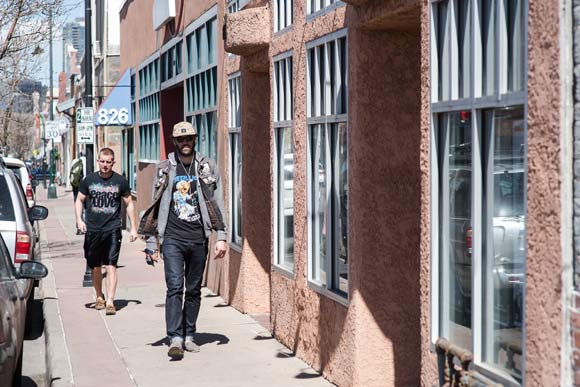 Photo by Kara Pearson Gwinn.
Photo by Kara Pearson Gwinn.
Over the last decade and a half, Denver's Art District on Santa Fe has emerged every bit a national standout. How can it build on its past successes without diminishing what fabricated information technology special in the start place?
The Art Commune on Santa Fe has long been a crossroads, located at the intersection of Santa Fe Drive, which follows the old borderland trail to Santa Fe, New Mexico, and U.South. vi, the prime road west to the Continental Divide before I-70.
Location helped make the area a center for commerce and manufacturing more than than a century ago. Many of the buildings served as factories and warehouses in the late 1800s. The industrial nature of the strip kept it gritty, and that kept it cheap.
And that affordability was integral in its ascendance equally a artistic commune in recent decades. In the belatedly 1990s and early 2000s, every bit rents jumped on Broadway and in the Ballpark neighborhood, artists started looking for cheaper studios and galleries. The sometime buildings on Santa Fe Drive were ideal, and soon there was a disquisitional mass of galleries a mile south of downtown.
Michael Burnett, owner of SPACE Gallery, was i of the outset artists to move south from Ballpark to the Art District on Santa Atomic number 26 when rents spiked downtown. "We started out in 2001 at 20th and Larimer," says Burnett.
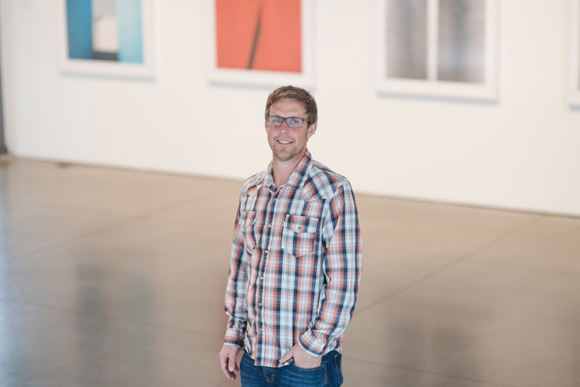 Michael Burnett opened the original SPACE Gallery in 2003. Photo by Kara Pearson Gwinn.
Michael Burnett opened the original SPACE Gallery in 2003. Photo by Kara Pearson Gwinn.
He caught wind of Jeanie King'south plans for Fresh Fine art Gallery and rented a ane,400-square-foot infinite at 765 Santa Fe Dr. "She and I opened on the same night [in Jan. 2003]," he says.
It was the commencement of a new era for the neighborhood. "At that place was enough of a concentration that information technology tipped," says Burnett. "It was the perfect tempest. There was real estate that was cheap that lent itself to good gallery space," with high ceilings, abundant natural light and 2d stories for studios and living quarters. "Artists don't need much," he says.
Afterwards in 2003, Jack Pappalardo, a lawyer, and his married woman, artist Georgia Amar, bought their iii-story building at 828 Santa Fe Dr. that housed a millinery -- a hat factory -- in 1883 and transformed into information technology a gallery and studio. In the early 2000s, for around $300,000, an artist could purchase "a archetype live/work space," he says.
The Art District on Santa Fe was established that yr with 17 galleries. Pappalardo, who served as president for 10 of the system's first 13 years, says the membership dropped to 12 after one yr. Dues were $50 a month, and it was simply too steep for struggling businesses.
Pappalardo dropped dues to $30 a month, and opened membership up to a broader base of businesses. "I followed the lead of The Rise of the Creative Class," he says. The landmark Richard Florida book "talked about the economic do good of the creative grade and quantified it."
The strategy worked as the district'due south membership grew to include about 70 artists and businesses today, including dozens of galleries. "Nosotros grew steadily every year from 2004 on," says Pappalardo. "What has changed, we've attracted a wider variety of businesses down here. It's not just galleries."
Renowned lensman John Fielder relocating his gallery from Cherry Creek North in 2006 was "a stamp of approving," says Pappalardo. "We've had a lot of steps like that, milestones that took us to the adjacent level." Three large ones, he says, were Su Teatro acquiring the Denver Civic Theater and Metropolitan State University of Denver opening the Center for Visual Art (CVA), both in 2010, and the 2014 opening of the new Colorado Ballet building.
Along the style, Get-go Friday emerged equally a phenomenon. The first such outcome in 2003 drew about 20 people to two galleries. The Aug. 2016 edition attracted a crowd of xiv,000. 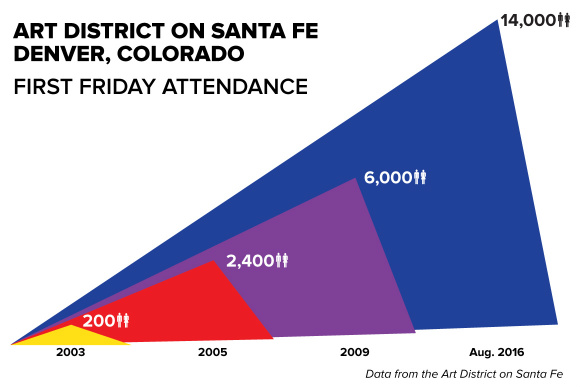
Back to the time to come
When the district's lath turned over in March 2016, Amy Phare took over for Pappalardo as president.
"If at that place's ane thing we're all virtually this year, it's community and admission," says Phare, who works in philanthropy past day. "I think that is one thing that's absurd nigh our neighborhood: the diversity. Nosotros celebrate a number of cultures." She says the goal for 2017 is to "break down gallery walls."
Another goal: a large investment in the street itself. "Santa Fe Bulldoze has not seen any infrastructure improvements in 30 years," says Phare.
There'due south a push to go funding from the General Obligation Bond that will exist on the November ballot in Denver. For $7.7 1000000, requite or take $1 million, such a projection would widen the sidewalks and improve infrastructure on Santa Iron Drive between sixth and 14th avenues.
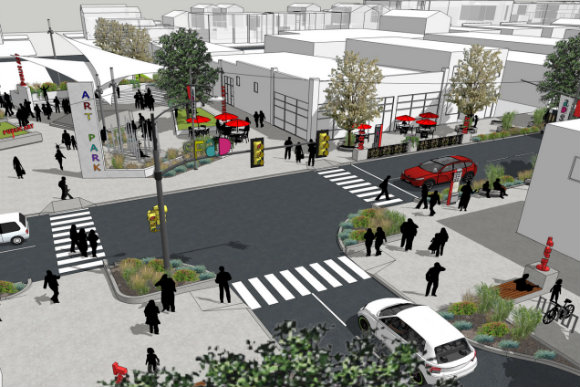 The plan calls for wider sidewalks, a plaza and public art. Rendering courtesy QUA+D.
The plan calls for wider sidewalks, a plaza and public art. Rendering courtesy QUA+D.
"We definitely have a voice in trying to get part of the $550 one thousand thousand that's on the tabular array right now," says Phare. "Only it's all politics at the end of the 24-hour interval. Just because we have the need doesn't mean nosotros're going to go the funds."
Architect Marker Raeburn of QUA+D has helped develop the plan, and highlights accessibility, safe and sustainability every bit big priorities. "The sidewalks don't actually come across the Americans with Disabilities Act or the city's pedestrian plan," says Raeburn. "They aren't prophylactic right now."
At certain bottlenecks, there's just two anxiety betwixt gas meters mounted on storefronts and streetlights. "The sidewalks are crumbling and you tin't walk adjacent," says Raeburn. "I can't tell you how many times I've walked into a light pole."
The plan calls for the elimination of one lane of traffic to make room for wider, ADA-compliant sidewalks, and adding upgraded lighting, public fine art, branded signage and a pedestrian-only plaza on 9th Avenue between Santa Iron Drive and Inca Street.
"We're proposing turning part of the street into a hardscaped urban plaza," says Phare of the terminal element. "I feel that's what'southward really missing." She describes it equally both "an art park" and a "community gathering space."
Adds Raeburn: "These improvements are not just so we tin bring 14,000 people on Starting time Friday. These improvements are being made for the permanent economic development of the corridor."
It harks back to the days when both Kalamath Street and Santa Fe Bulldoze were two-mode streets, earlier the suburban boom of the 1970s and '80s led to the development of feeder routes heading downtown.
The programme "makes it a neighborhood street," says Pappalardo. "In a way, information technology'south dorsum to the hereafter."
That means reinventing the commune as a walkable neighborhood that'due south an endpoint, non a cut-through. "Nosotros desire Santa Fe Bulldoze to exist a destination," says Phare. "We have kids here, we want this to be a safe destination, not a thoroughfare, non a highway, not a speed zone."
People headed downtown "are trying to become from point A to point B. Nosotros want Santa Iron Drive to exist betoken B." 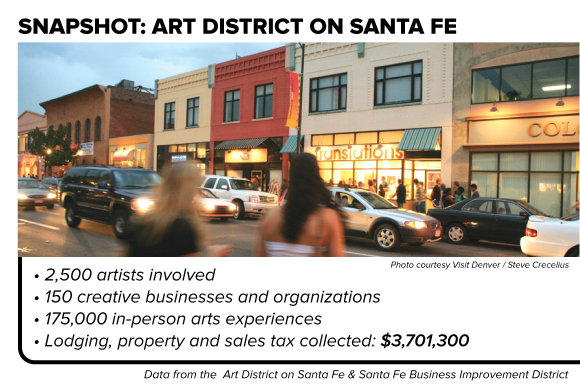
A new crossroads
With the district'due south success, gentrification and displacement threaten to upset the catchy balance between arts and commerce. Rents accept risen and artists have moved. Jigg'due south Barber Store, a fixture at 836 Santa Fe Dr., is closing after 56 years. Owner Eddie Gomez recently sold it to an as-yet-undisclosed buyer who's planning to open a gallery.
Nonetheless, Santa Iron Bulldoze remains a real urban street, with garages and lawnmower repair shops and carwashes. But the mainstays are now galleries instead of factories -- with the exception of a few manufacturers like Knotty Tie Co. -- and there'southward also a off-white corporeality of new residential evolution.
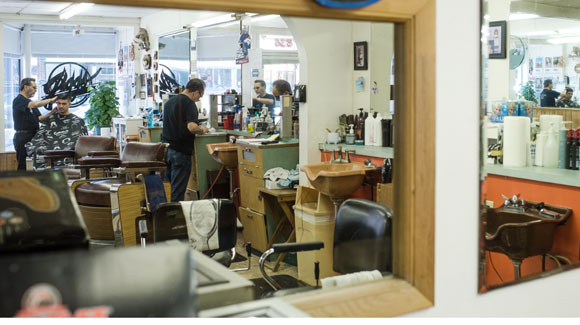 Jigg's Barber Shop is closing after more than 50 years on Santa Fe Drive. Photograph by Kara Pearson Gwinn.
Jigg's Barber Shop is closing after more than 50 years on Santa Fe Drive. Photograph by Kara Pearson Gwinn.
A major catalyst is just iii blocks west. "The thing that's tied the whole thing together is the Mariposa project," says Pappalardo. The mixed-income housing project is tripling its density with redevelopment, providing a nearby source of customers for businesses beyond galleries.
But the ascension price of real estate is a roadblock for upwards-and-coming artists looking to plant roots in the Art District on Santa Atomic number 26.
Muralist Forrest Morrison has rented a studio in the district since 2012, and rent increased by nearly 30 percent in the last three years. "This isn't white picket fences, simply in that location is open up collaboration between neighbors here and a sense that we are all working towards the same goals," he says. "It's the kind of community I think many of u.s.a. would choose for ourselves, and it has been invaluable to my practice and career."
He's non alone, but information technology'southward getting harder to bring in new blood. In 2003, Jeanie Male monarch opened Fresh Art Gallery in the building that now houses Cadre New Fine art Infinite and Spark Gallery at 900 Santa Atomic number 26 Dr. She bought it for $320,000 in 2002, invested about $250,000 in improvements over the years and sold information technology to public art maestro Lawrence Argent for $890,000 in 2016.
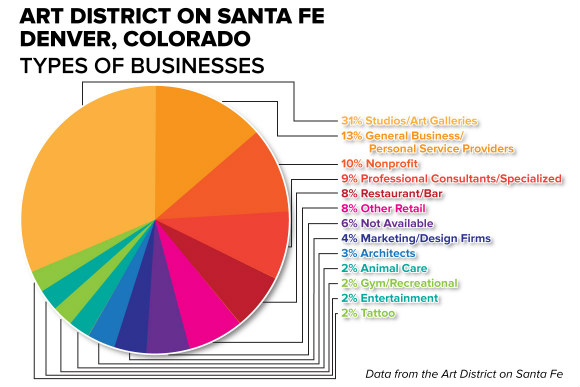
King so considered buying another edifice in the neighborhood. "All the artists started calling me: 'Rents are going upwardly,'" she says. "I idea peradventure I could help out, just information technology'southward incommunicable to detect an affordable building."
As a result, she turned her sights northeast and bought a former hog subcontract on 11 acres in Commerce Urban center, where she plans to open 12 studios as the first stage of Concept Colorado in late 2017.
King says she now fears "a mass exodus" of artists from the Fine art District on Santa Fe.
It's partially due to the emergence of a more than mixed-utilize district. New breweries and restaurants are on the way, including Intrepid Sojourner Beer Project at 925 W. 8th Ave. and Smokin Yard'south BBQ at The Yard at second Avenue and Santa Iron.
And there could be more than to come. Says Pappalardo: "Nosotros're still looking for that i destination restaurant, a chef-driven restaurant. I've had discussions with a lot of them. Virtually mention parking as an issue."
Phare says she likes the influx of new businesses, just describes information technology as a double-edged sword. "It's hard. I live in the neighborhood," she says. "Of form, I desire admission to more restaurants, bars, nightlife, shops and boutiques. But with that comes gentrification and I call back nearly that every day."
She says college rent "pushes out the very reason this neighborhood came near. It could push out artists renting studio infinite. It could push button out the rich Latino civilisation. I don't have the answer to that."
Information technology'south not an piece of cake problem to solve. Her all-volunteer board oversees an annual budget of about $30,000. "We but don't have the bandwidth," says Phare. "Nosotros don't have whatever paid staff. I've been putting in fashion more than time than is sustainable."
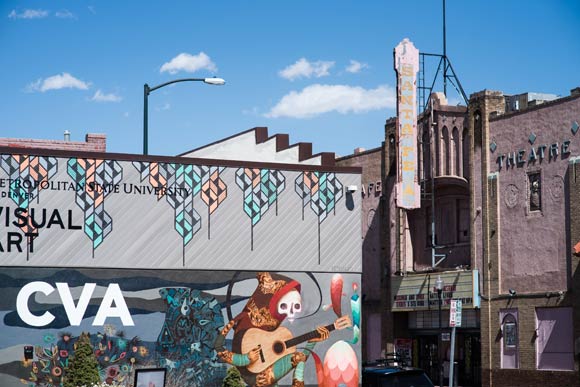 Metro State opened its Center for Visual Art at 965 Santa Fe Dr. in 2010. Photo by Kara Pearson Gwinn.
Metro State opened its Center for Visual Art at 965 Santa Fe Dr. in 2010. Photo by Kara Pearson Gwinn.
The Santa Iron Business Improvement District (BID), founded in 2014, is helping maintain the area between 7th and 12th avenues, but Phare says there's still a need for more resources. "We don't only get funding because nosotros're an art district," she says. "We have to exercise out own due diligence to create a strong, fiscally sustainable programme." That involves more grant applications, more sponsorships, and more members.
First Friday "is the 1 dark we tin actually brand coin," adds Phare, noting that street closures and a new art film series set up for the CVA parking lot offer additional sponsorship opportunities. "In that location are businesses that want to support the arts."
Southern migration
When Colorado Artistic Industries (CCI) designated the Art District on Santa Iron equally i of the first two Colorado Creative Districts (along with Salida) in 2012, Pappalardo elected to expand the boundaries across the heart of the gallery strip between 6th and twelfth avenues on Santa Fe Drive; the commune encompasses several blocks on Inca Street likewise equally the more than industrial stretch of Santa Fe down to Alameda Avenue.
"I did that because I saw what was happening in River North and how an industrial area was buying into creative industries," says Pappalardo.
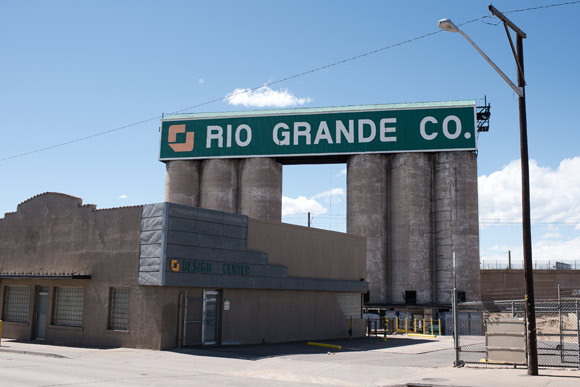 The southern cease of the creative district is largely industrial. Photo by Kara Pearson Gwinn.
The southern cease of the creative district is largely industrial. Photo by Kara Pearson Gwinn.
Five years later, the move looks prescient. Burnett moved Space Gallery south three blocks to a new edifice in 2014. With an event-friendly gallery in heed, he signed a 2-year lease on the vacant parcel at 400 Santa Atomic number 26 Dr. "with couches and mattresses and junk all over" in 2011.
Burnett couldn't beget to buy it, and so he devised a programme, hired an architect and started shopping the idea to banks. "We did it in opposite," he says. Wells Fargo somewhen flake, Burnett bought the lot and built the new and improved SPACE Gallery from the ground upwards. It opened in 2014, with capacity for 300 people at about 100 events a year.
"Build it and they will come," says Burnett. "When at that place'due south a beautiful space with big walls, artists imagine their work on it."
But it's function of a broader trend. Phare says loftier taxes stemming from property values increasing in RiNo are "why all of the artists are moving down to Santa Atomic number 26."
Opening in Sept. 2016 after two years on Walnut Street, Rule Gallery at 530 Santa Iron Dr. is one of the more recent transplants from RiNo. Co-owner Valerie Santerli says she looked at spaces in RiNo also every bit options on Navajo Street and Colfax Artery before opting for the Art Commune on Santa Fe. 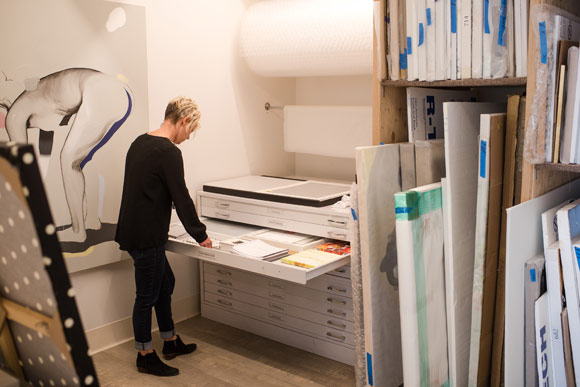 Valerie Santerli is 1 of the owners of Rule Gallery. Photograph by Kara Pearson Gwinn.
Valerie Santerli is 1 of the owners of Rule Gallery. Photograph by Kara Pearson Gwinn.
She sees a benefit to being south of 6th Avenue. "The people who trickle downward this way are very defended people who are willing to get further to see good art."
Notes co-owner Rachel Beitz: "Nosotros've had a much better flow of walk-ins than we always did in RiNo."
Santerli adds, "I wouldn't participate in Outset Friday if we were up north." Why? It'due south too much of a party. Just the Third Friday collectors-oriented events bring "a more than sober, more mature crowd."
And beyond Rule and SPACE, the creative commune continues to see more energy flow into its southern reaches. Betwixt 1st 2d Avenue, The Yard is a former lumberyard that'southward now home to the Renegade Brewing production facility, furniture maker Fin Art and other businesses.
Phil Bough of Pirate: Contemporary Art is looking for a new location for the Navajo Street gallery and considering a building on the 200 block of Santa Fe as well as a space at 40th Artery and York Street, or maybe one in Lakewood. He says the deal is "upwardly in the air," noting, "We hope it works out, merely we're not sure it will. . . . The price kept creeping upwardly."
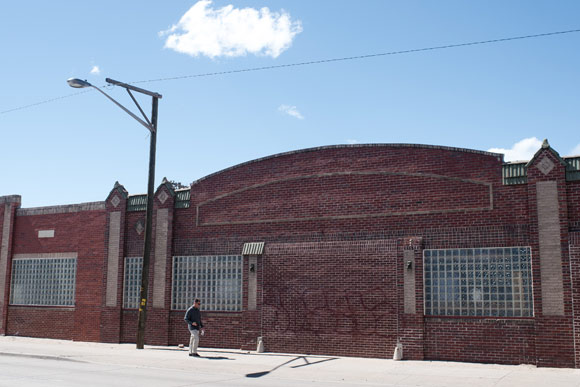 Industrial redbricks populate the southern end of the Art District on Santa Iron. Photograph past Kara Pearson Gwinn.
Industrial redbricks populate the southern end of the Art District on Santa Iron. Photograph past Kara Pearson Gwinn.
The real McCoy
With the ascent toll of real estate, Morrison says, "I exercise not think information technology'south sustainable. I think we all recognize that an art district cannot survive without evolution that sustains and complements the artistic sector and working-class artists."
He notes that at that place's a massive disparity in rents; some properties are advertised equally being "downtown" and priced higher than others. "A united existent-manor identity would help stabilize rents in the brusque term, and would ensure we don't soon lose the community and culture that has fabricated this neighborhood so valuable to brainstorm with," notes Morrison.
SPACE Gallery's Burnett says that more than artists owning properties would provide a boost to the Art District on Santa Fe. "As long every bit people continue to rent, it'due south going to experience transient," says Burnett. "The best manner to practice information technology is buy a building, but most artists can't afford to exercise that. Everybody's boot themselves now that they didn't." Artists and creative businesses need to look into favorable financing and incentive programs and leverage them, he adds.
Jeanie King says that the 29 per centum assessment rate on commercial property is a huge brunt for galleries. "It would exist really swell of the land could make a taxation intermission for arts studios," she says. "That would be huge."
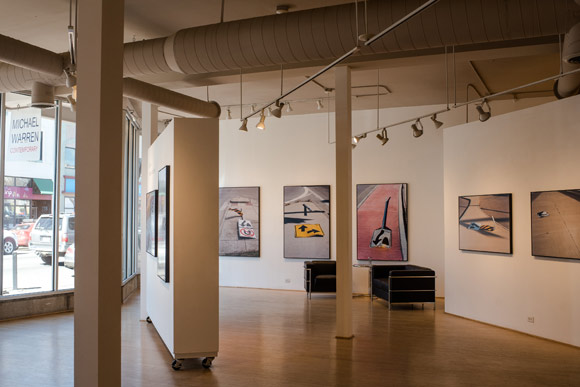 Michael Warren Contemporary opened at 760 Santa Atomic number 26 Dr. in 2014. Photo by Kara Pearson Gwinn.
Michael Warren Contemporary opened at 760 Santa Atomic number 26 Dr. in 2014. Photo by Kara Pearson Gwinn.
Without a break of some kind, it might be difficult to keep galleries if the proposed improvements come to fruition. "We need the OED to help come up up with a solution for that," says QUA+D'due south Raeburn. "If your building is owned by an artist or creative or houses artists and creatives, maybe there could be some sort of staggered tax increases."
Financials aside, keeping the focus squarely on artists and their work is also disquisitional. "Is it nearly the arts or the economics?" asks Pappalardo. "It's really fiscal support that nosotros need and promotional back up we need. I'd dear CCI to partner with the Colorado Tourism Office more than and get more than purchase-in from the Metropolis of Denver."
He adds, "People are starting to circle dorsum and discover usa over again. We really are one of the peak districts in the entire country."
And that's ultimately because of the creative people who piece of work and exhibit there. "You lot cannot start an art district," says artist Georgia Amar, Pappalardo's married woman, and calls the Fine art District on Santa Fe a "grassroots, bottom-up" phenomenon.
It'due south about the artists, their piece of work and their power to make a living, she adds. "The quality of art is getting better and better," says Amar. "Now we accept to focus on the real McCoy."
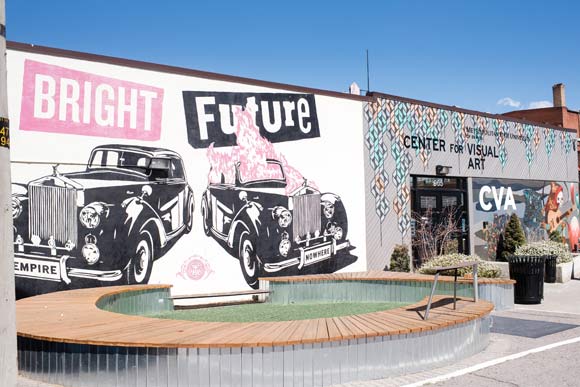 Murals at the Center for Visual Art. Photograph by Kara Pearson Gwinn.
Murals at the Center for Visual Art. Photograph by Kara Pearson Gwinn.
Photos by Kara Pearson Gwinn. Rendering courtesy QUA+D. Graphic design by Matt Megyesi. This story is part of a series about Colorado's Certified Artistic Districts. Back up for this series is provided byColorado Creative Industries.
Source: https://www.confluence-denver.com/features/cci-art-district-on-santa-fe-032917.aspx
0 Response to "Tie One on Is to Be Located in the Historic River North Art District Near Downtown Denver"
Post a Comment